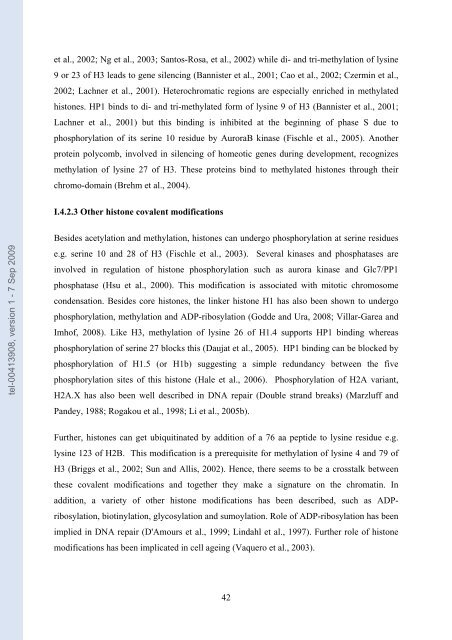Etudes sur le mécanisme de remodelage des nucléosomes par ...
Etudes sur le mécanisme de remodelage des nucléosomes par ...
Etudes sur le mécanisme de remodelage des nucléosomes par ...
Create successful ePaper yourself
Turn your PDF publications into a flip-book with our unique Google optimized e-Paper software.
tel-00413908, version 1 - 7 Sep 2009<br />
et al., 2002; Ng et al., 2003; Santos-Rosa, et al., 2002) whi<strong>le</strong> di- and tri-methylation of lysine<br />
9 or 23 of H3 <strong>le</strong>ads to gene si<strong>le</strong>ncing (Bannister et al., 2001; Cao et al., 2002; Czermin et al.,<br />
2002; Lachner et al., 2001). Heterochromatic regions are especially enriched in methylated<br />
histones. HP1 binds to di- and tri-methylated form of lysine 9 of H3 (Bannister et al., 2001;<br />
Lachner et al., 2001) but this binding is inhibited at the beginning of phase S due to<br />
phosphorylation of its serine 10 residue by AuroraB kinase (Fisch<strong>le</strong> et al., 2005). Another<br />
protein polycomb, involved in si<strong>le</strong>ncing of homeotic genes during <strong>de</strong>velopment, recognizes<br />
methylation of lysine 27 of H3. These proteins bind to methylated histones through their<br />
chromo-domain (Brehm et al., 2004).<br />
I.4.2.3 Other histone cova<strong>le</strong>nt modifications<br />
Besi<strong>de</strong>s acetylation and methylation, histones can un<strong>de</strong>rgo phosphorylation at serine residues<br />
e.g. serine 10 and 28 of H3 (Fisch<strong>le</strong> et al., 2003). Several kinases and phosphatases are<br />
involved in regulation of histone phosphorylation such as aurora kinase and Glc7/PP1<br />
phosphatase (Hsu et al., 2000). This modification is associated with mitotic chromosome<br />
con<strong>de</strong>nsation. Besi<strong>de</strong>s core histones, the linker histone H1 has also been shown to un<strong>de</strong>rgo<br />
phosphorylation, methylation and ADP-ribosylation (God<strong>de</strong> and Ura, 2008; Villar-Garea and<br />
Imhof, 2008). Like H3, methylation of lysine 26 of H1.4 supports HP1 binding whereas<br />
phosphorylation of serine 27 blocks this (Daujat et al., 2005). HP1 binding can be blocked by<br />
phosphorylation of H1.5 (or H1b) suggesting a simp<strong>le</strong> redundancy between the five<br />
phosphorylation sites of this histone (Ha<strong>le</strong> et al., 2006). Phosphorylation of H2A variant,<br />
H2A.X has also been well <strong>de</strong>scribed in DNA repair (Doub<strong>le</strong> strand breaks) (Marzluff and<br />
Pan<strong>de</strong>y, 1988; Rogakou et al., 1998; Li et al., 2005b).<br />
Further, histones can get ubiquitinated by addition of a 76 aa pepti<strong>de</strong> to lysine residue e.g.<br />
lysine 123 of H2B. This modification is a prerequisite for methylation of lysine 4 and 79 of<br />
H3 (Briggs et al., 2002; Sun and Allis, 2002). Hence, there seems to be a crosstalk between<br />
these cova<strong>le</strong>nt modifications and together they make a signature on the chromatin. In<br />
addition, a variety of other histone modifications has been <strong>de</strong>scribed, such as ADP-<br />
ribosylation, biotinylation, glycosylation and sumoylation. Ro<strong>le</strong> of ADP-ribosylation has been<br />
implied in DNA repair (D'Amours et al., 1999; Lindahl et al., 1997). Further ro<strong>le</strong> of histone<br />
modifications has been implicated in cell ageing (Vaquero et al., 2003).<br />
42

















